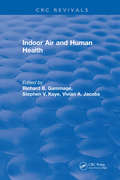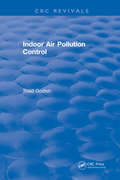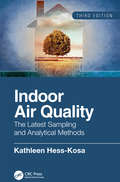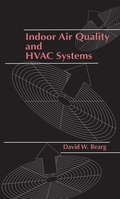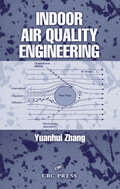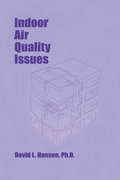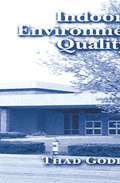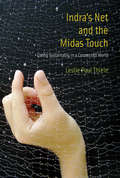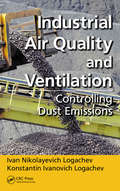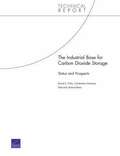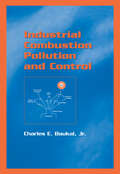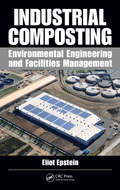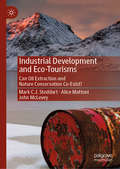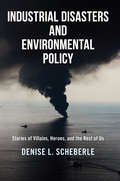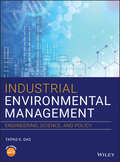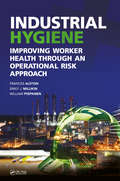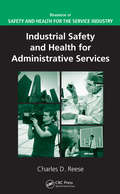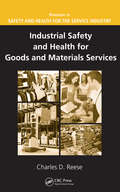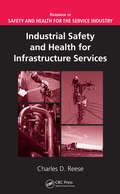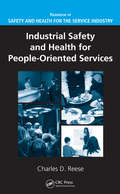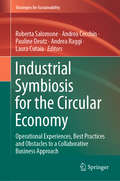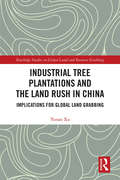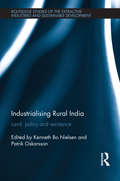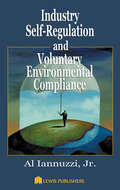- Table View
- List View
Indoor Air and Human Health
by Richard B. GammageThe data have been presented in forms that can best permit evaluations of health implications. Alternatively, the data help us identify gaps in knowledge that need to be filled before such evaluations can be made. The pollutant classes are examined from viewpoints such as measurement and source characterization, habitat studies, health effects, risk analysis, and future needs.
Indoor Air Pollution Control
by Thad GodishThis is an all new book designed to provide you the practical information and data you need for indoor air pollution control! Presented early in the book is theory as support for the applications that follow; including a synthesized review of the significant literature on controlling air pollution. Practical applications-largely from the author's own experience-deal with 1) How to conduct indoor air quality investigations in both residences and public access buildings, 2) Indoor air quality mitigation practice, and 3) Case histories. This book will be very useful to consultants and other professionals who grapple to solve real world problems. And it will make an excellent textbook for new courses in indoor air quality. Indoor Air Pollution Control will be used for control and prevention of contaminated air in homes, apartment buildings, office buildings (large and small), hospitals, auditoriums, and other public buildings.
Indoor Air Quality: The Latest Sampling and Analytical Methods, Third Edition
by Kathleen Hess-KosaIndoor Air Quality: The Latest Sampling and Analytical Methods, Third Edition is a practical, user-friendly guide to the identification and assessment of the indoor air contaminants that contribute to building-related illness in commercial buildings, institutions, and residences. It covers the basic concepts of indoor air quality assessment, including its historic evolution. The book describes the most common substances encountered in an indoor air quality investigation, their health effects, and their occurrence in the environment. Drawing from the author’s experience, observations, and extensive research, this easy-to-read guide provides readers with a working knowledge of the latest approaches to sampling protocols and cutting-edge trends as well as suggested sampling strategies, helpful experience related tips, and a means for interpreting results. Additionally, in the later part of the book, there is considerable discussion of failure modes of building materials and systems—sources of many indoor air quality problems! This third edition details up-to-date strategies and analytical methods and addresses some of the more recent, as well as less common, concerns on indoor air pollutants. All chapters in the third edition have been updated to adhere to the more recent developments in indoor air quality. Also a new chapter on the illusive data and sampling approaches on ozone has been added. New in the Third Edition Revised and updated standards and guidelines Updated U.S. EPA NAAQS Updated LEEDv4 Standard Updated ANSI/ASHRAE Standard 189.1 Latest approaches to sampling and analytical methods Expanded discussion on controversial inhalable airborne particulate sampling methods Updated and expanded tables and data Updated and expanded figures and schematics Inclusion of a new chapter on ozone
Indoor Air Quality and HVAC Systems
by David W. BeargIndoor Air Quality and HVAC Systems is a practical guide for understanding the relationship between the design, installation, operation, and maintenance of HVAC systems and achieving indoor air quality (IAQ). The book describes the individual components of HVAC systems and the role each plays in maintaining good indoor air quality. It also identifies the techniques available for evaluating the performance characteristics of ventilation systems (including the use of carbon dioxide monitors and sulfur hexafluoride tracer testing equipment). Other topics discussed include the determination of pathways of air movement through buildings and understanding pressure relationships, ventilation effectiveness, and efficiency. The book concludes with an overview of sources of air contaminants to be concerned about when performing an IAQ evaluation. Indoor Air Quality and HVAC Systems provides critical information for industrial hygienists, HVAC contractors and engineers, and building owners and managers.
Indoor Air Quality Engineering
by Yuanhui ZhangIndoor Air Quality Engineering covers a wide range of indoor air quality engineering principles and applications, providing guidelines for identifying and analyzing indoor air quality problems as well as designing a system to mitigate these problems. Structured into three sections - properties and behavior of airborne pollutants, measurement and sa
Indoor Air Quality Issues
by David L. HansenThis text examines problems such as microbial contamination, building design, ventilation systems and psychological effects. It uses a multi-disciplined approach in examining the causes and effects of the interactions between occupants and non-industrial environments. The text also provides the reader with a tool for diagnosing IAQ problems and effectively reducing them.
Indoor Environmental Quality
by Thad GodishWhen we think of indoor pollution, we usually think of conditions originating from faulty ventilation systems, second hand smoke, and other air borne pollutants. Taking an in-depth, hard science look at the problems of indoor environmental pollution, Indoor Environmental Quality covers all the major indoor contaminants - inorganic, organic, and bio
Indra's Net and the Midas Touch: Living Sustainably in a Connected World
by Leslie Paul ThieleAn exploration of the impact of unintended consequences in an interdependent world and of the opportunities for creativity and community.We live today in a global web of interdependence, connected technologically, economically, politically, and socially. As a result of these expanding and deepening interdependencies, it has become impossible fully to control—or foretell—the effects of our actions. The world is rife with unintended consequences. The first law of human ecology—which declares that we can never do merely one thing—is a truth we ignore at our peril. In Indra's Net and the Midas Touch, Leslie Paul Thiele explores the impact of interdependence and unintended consequences on our pursuit of sustainability. Unfortunately, good intentions provide no antidote to the law of unintended consequences, and proffered cures often prove worse than the disease. Biofuels developed for the purpose of reducing carbon emissions, for example, have had the unintended effect of cutting off food supplies to the needy and destroying rain forests. We must fundamentally transform our patterns of thinking and behavior. Thiele offers the intellectual and moral foundations for this transformation, drawing from ecology, ethics, technology, economics, politics, psychology, physics, and metaphysics. Awareness of our interconnectedness, he writes, stimulates creativity and community; it is a profound responsibility and a blessing beyond measure.
Industrial Air Quality and Ventilation: Controlling Dust Emissions
by Ivan Nikolayevich Logachev Konstantin Ivanovich LogachevIn the field of industrial ventilation and air quality, a lack of adequate analysis for aerodynamic processes, as well as a shortage of properly equipped computer facilities, has forced specialists to rely on an empirical approach to find answers in the past. Commonly based on crude models, practical data, or countertypes, the answers often offered
The Industrial Base for Carbon Dioxide Storage: Status and Prospects
by David S. Ortiz Constantine Samaras Edmundo Molina-PerezIf policies aimed at large reductions of carbon dioxide (CO2) emissions are enacted, more carbon capture and storage will be needed. RAND researchers explored the ability of the industrial base supporting the transportation and sequestration of CO2 to expand, assessing the industrial base for transportation and injection of CO2 for both geologic storage and enhanced oil recovery.
Industrial Combustion Pollution and Control (Environmental Science And Pollution Ser. #Vol. 27)
by Jr. Charles E. BaukalThis reference overflows with an abundance of experimental techniques, simulation strategies, and practical applications useful in the control of pollutants generated by combustion processes in the metals, minerals, chemical, petrochemical, waste, incineration, paper, glass, and foods industries. The book assists engineers as they attempt to meet e
Industrial Composting: Environmental Engineering and Facilities Management
by Eliot EpsteinThe ultimate in recycling, composting has been in use in some form since ancient times. A well-managed composting facility should exist as a good neighbor contributing to ecology. However, since local populations often perceive risks if a composting facility is built nearby, composting facilities must be designed and operated with minimal odor, dus
Industrial Development and Eco-Tourisms: Can Oil Extraction and Nature Conservation Co-Exist?
by Mark C.J. Stoddart Alice Mattoni John McLeveyThis book examines the “oil-tourism interface”, the broad range of direct and indirect contact points between offshore oil extraction and nature-based tourism. Offshore oil extraction and nature-based tourism are pursued as development paths across the North Atlantic region. Offshore oil promises economic benefits from employment and royalty payments to host societies, but is based on fossil fuel-intensive resource extraction. Nature-based tourism, instead, is based on experiencing natural environments and encountering wildlife, including whales, seals, or seabirds. They share social-ecological space, such as oceans, coastlines, cities and towns where tourism and offshore oil operations and offices are located. However, they rarely share cultural or political space, in terms of media coverage, public debate, or policy discussion that integrates both modes of development. Through a comparative analysis of Denmark, Iceland, Newfoundland and Labrador, Norway, and Scotland, this book offers important lessons for how coastal societies can better navigate relationships between resource extraction and nature-based tourism in the interests of social-ecological wellbeing.
Industrial Disasters and Environmental Policy: Stories of Villains, Heroes, and the Rest of Us
by Denise L. ScheberleEnvironmental stories have all the elements of a good drama—villains that plunge the world into danger and heroes that fight for positive change. Industrial Disasters and Environmental Policy: Stories of Villains, Heroes, and the Rest of Us illuminates the interplay between environmental policies and the people and groups who influence their development and implementation. Through the stories of four major industrial disasters—the Union Carbide plant explosion, the BP oil spill, the Upper Big Branch Mine explosion, and the asbestos poisoning in Libby, Montana—this book examines the organizational breakdowns and regulatory lapses that caused these disasters, and how attitudes and policies changed as a result. It also explores the achievements of environmental heroes like Gaylord Nelson and Judy Bonds and how their activism has shaped US environmental politics and policies. Industrial Disasters and Environmental Policy concludes with a discussion of how the "rest of us" can participate in everyday environmental actions, hold corporations and the government accountable, and lobby for greater environmental protections. With its compelling stories and calls to action, this book helps students understand how US environmental policies have developed and transformed—and how they can continue to do so.
Industrial Environmental Management: Engineering, Science, and Policy
by Tapas K. DasProvides aspiring engineers with pertinent information and technological methodologies on how best to manage industry's modern-day environment concerns This book explains why industrial environmental management is important to human environmental interactions and describes what the physical, economic, social, and technological constraints to achieving the goal of a sustainable environment are. It emphasizes recent progress in life-cycle sustainable design, applying green engineering principles and the concept of Zero Effect Zero Defect to minimize wastes and discharges from various manufacturing facilities. Its goal is to educate engineers on how to obtain an optimum balance between environmental protections, while allowing humans to maintain an acceptable quality of life. Industrial Environmental Management: Engineering, Science, and Policy covers topics such as industrial wastes, life cycle sustainable design, lean manufacturing, international environmental regulations, and the assessment and management of health and environmental risks. The book also looks at the economics of manufacturing pollution prevention; how eco-industrial parks and process intensification will help minimize waste; and the application of green manufacturing principles in order to minimize wastes and discharges from manufacturing facilities. Provides end-of-chapter questions along with a solutions manual for adopting professors Covers a wide range of interdisciplinary areas that makes it suitable for different branches of engineering such as wastewater management and treatment; pollutant sampling; health risk assessment; waste minimization; lean manufacturing; and regulatory information Shows how industrial environmental management is connected to areas like sustainable engineering, sustainable manufacturing, social policy, and more Contains theory, applications, and real-world problems along with their solutions Details waste recovery systems Industrial Environmental Management: Engineering, Science, and Policy is an ideal textbook for junior and senior level students in multidisciplinary engineering fields such as chemical, civil, environmental, and petroleum engineering. It will appeal to practicing engineers seeking information about sustainable design principles and methodology.
Industrial Hygiene: Improving Worker Health through an Operational Risk Approach (Sustainable Improvements in Environment Safety and Health)
by Frances Alston Emily J. Millikin Willie PiispanenOver the past forty years, the Industrial Hygiene profession has significantly grown, and is expected to continue to grow as workplaces evolve in the development, management, and usage of hazardous materials. This growth in the profession is also related to the shift in public knowledge and perception regarding the acceptance of the health risk from activities performed at work and home. As time progresses, workplaces are being regulated to not only minimize the health imparts to the workforce, but also decrease the likelihood of negatively impacting the environment. Society has become more educated on the potential impacts on human health and the environment that hazardous materials, activities, and environments can pose. As such, there has been a noticeable decrease in the acceptance of risk by workers and the public. The accepted standard of performance for Industrial Hygiene has grown beyond compliance, but now also focuses on improving existing processes and practices to create a workplace free from work related injury and illness. <P><P>Features: <li>Shows application of risk mitigating techniques for industrial hygienists <li>Explains the definition of risk and how it applies to health and safety management <li>Defines the need for quality data management and continuous improvement in assessments <li>Describes the role of the Industrial Hygienist and risk management when responding to emergencies <P><P>Industrial Hygiene: Improving Worker Health through an Operational Risk Approach focuses on the implementation of Industrial Hygiene, using a risk-based approach, in an operational environment. The approaches and methods described in this book are designed to assist the Industrial Hygienist in managing workplace risks, including risks associated with anticipation, recognition, evaluation, and hazard control processes.
Industrial Safety and Health for Administrative Services (Handbook of Safety and Health for the Service Industry)
by Charles D. ReeseIndustrial Safety and Health for Administrative Services constitutes a much-needed source for the identification and prevention of most of the injuries and illnesses occurring in the financial and information sectors. The text thoroughly explains the issues of office health management, major safety and electrical hazards, and emergency response to
Industrial Safety and Health for Goods and Materials Services (Handbook of Safety and Health for the Service Industry)
by Charles D. ReeseIndustrial Safety and Health for Goods and Materials Services focuses on the safety requirements of the wholesale and retail trades, including warehousing. This detailed text describes the hazards associated with chemicals, compressed gases, and fire. In addition to discussing the ergonomics behind hand tools, ladders, machine guarding, material ha
Industrial Safety and Health for Infrastructure Services (Handbook of Safety and Health for the Service Industry)
by Charles D. ReeseIndustrial Safety and Health for Infrastructure Services provides an in-depth look into the areas of transportation, utilities, administrative, waste management, and remediation. It covers OSHA regulations in reference to the major safety and health hazards associated within these five fields. This user-friendly text:Provides guidance on removal, d
Industrial Safety and Health for People-Oriented Services (Handbook of Safety and Health for the Service Industry)
by Charles D. ReeseIndustrial Safety and Health for People-Oriented Services focuses on the safety requirements of the tertiary sector of industry's education, health, and hospitality services. This is an instruction manual on managing a safe and healthy environment- one free of biological, chemical, and ergonomics hazards - while adhering to OSHA regulations. In add
Industrial Symbiosis for the Circular Economy: Operational Experiences, Best Practices and Obstacles to a Collaborative Business Approach (Strategies for Sustainability)
by Roberta Salomone Andrea Raggi Andrea Cecchin Pauline Deutz Laura CutaiaThe book is designed to help public and private decision-makers and academics deepen their knowledge and understanding of the contexts, obstacles and challenges of a variety of business types involved in Industrial Symbiosis and Circular Economy practices.Industrial Symbiosis is reported in the Action Plan on the Circular Economy developed by the European Commission in 2015 (COM / 2015/0614 final) and in its revision of 14 March 2017, but relatively little is known of how these practices start, develop or fail, and mutate in a rapidly changing context.Including selected contributions presented at the 24th ISDRS 2018 Conference, “Actions for a Sustainable World: from theory to practice” in the two theme tracks “5c. Circular economy, zero waste & innovation” and “5g. Industrial symbiosis, networking and cooperation as part of industrial ecology”, this book offers a transdisciplinary perspective on real experiences of industrial symbiosis, performed both by industries and the scientific community, best practices, success and unsuccessful cases (implemented or under implementation), with the final aim to promote the adoption of Industrial Symbiosis as an operational and systematic tool for the Circular Economy. In particular, a focus on the environmental, social, and economic impact of Circular Economy and Industrial Symbiosis practices, and how those impacts may be context and/or scale dependent is given.
Industrial Tree Plantations and the Land Rush in China: Implications for Global Land Grabbing (Routledge Studies in Global Land and Resource Grabbing)
by Yunan XuThis book analyses the political and economic causes, mechanisms and impacts of the industrial tree plantation boom in China. In the past two decades, the industrial tree plantation sector has been expanding rapidly in China, especially in Guangxi Province. Based on extensive primary data, this book concentrates on the political economy of the sector’s expansion with a focus on the recent and dramatic agrarian transformation involving the land-labour nexus, the impact on villagers’ livelihoods, the role of the state, and political reactions from below. The book questions the stereotypical portrayal of local communities as the excluded villager. Instead, it demonstrates that this is a much more complex issue with varying levels of passive and active forms of inclusion and exclusion within local communities. While most literature focuses on crop booms for food and biofuel production the industrial plantation sector has largely been overlooked, despite it being one of the biggest sectors in the current rush for land. Filling this lacuna, this book also reveals that while China has traditionally been painted as a major land grabber and consumer of crop booms it is also a destination of foreign investment. In doing so the book highlights how large-scale foreign land deals can also take place in traditional ‘grabber’ countries like China which feeds into the wider debates about global land politics and resource grabbing. This book will be of great interest to students and scholars of land grabbing, rural development and agrarian transformations, as well as Chinese development.
Industrialising Rural India: Land, policy and resistance (Routledge Studies of the Extractive Industries and Sustainable Development)
by Kenneth Bo Nielsen Patrik OskarssonRapid industrialisation is promoted by many as the most feasible way of rejuvenating the Indian economy, and as a way of generating employment on a large scale. At the same time, the transfer of land from rural communities and indigenous groups for industrial parks, mining, or Special Economic Zones has emerged as perhaps the most explosive issue in India over the past decade. Industrialising Rural India sheds light on crucial political and social dynamics that unfold today as India seeks to accelerate industrial growth. The volume examines key aspects that are implicated in current processes of industrialisation in rural India, including the evolution of industrial and related policies; the contested role of land transfers, dispossession, and the destruction of the natural resource base more generally; and the popular resistance against industrial projects, extractive industries and Special Economic Zones. Combining the work of scholars long established in their respective fields with the refreshing approach of younger scholars, Industrialising Rural India seeks to chart new ways in the study of contemporary industrialisation and its associated challenges in India. This cutting-edge interdisciplinary work will be of interest to scholars working on industrial development and land questions in India and South Asia alongside those with an interest in sociology , political science and development research.
Industry Genius: Inventions and People Protecting the Climate and Fragile Ozone Layer
by Stephen Andersen Durwood ZaelkeThis book presents the inventive genius behind technological breakthroughs by ten global companies including Alcoa, DaimlerChrysler, Honda, ST Micro and Visteon. Readers will gain understanding and insight into how cutting-edge technology is helping protect the climate and/or the ozone layer, while contributing to the company's bottom line. Each chapter chronicles the challenge and triumph of invention, introduces the engineers and executives who overcome conventional wisdom, and demonstrates the contribution these companies are making to environmental protection. In full colour and crammed with graphics to illustrate the creative process of technological breakthroughs, the book is accessible and informative. The genius of these ten companies will inspire the engineer, the policy-maker, the student, the environmentalist, the CEO and the investor alike.
Industry Self-Regulation and Voluntary Environmental Compliance
by Jr., Al IannuzziWhy self-regulation? With the advent of such concepts as design for the environment, industrial ecology, and the recognized enlightened self-interest that voluntary compliance brings, it is in any company's best interest to avoid fines, liabilities, and bad publicity. Consumer concern and pressure from the marketplace give a competitive advantage t
